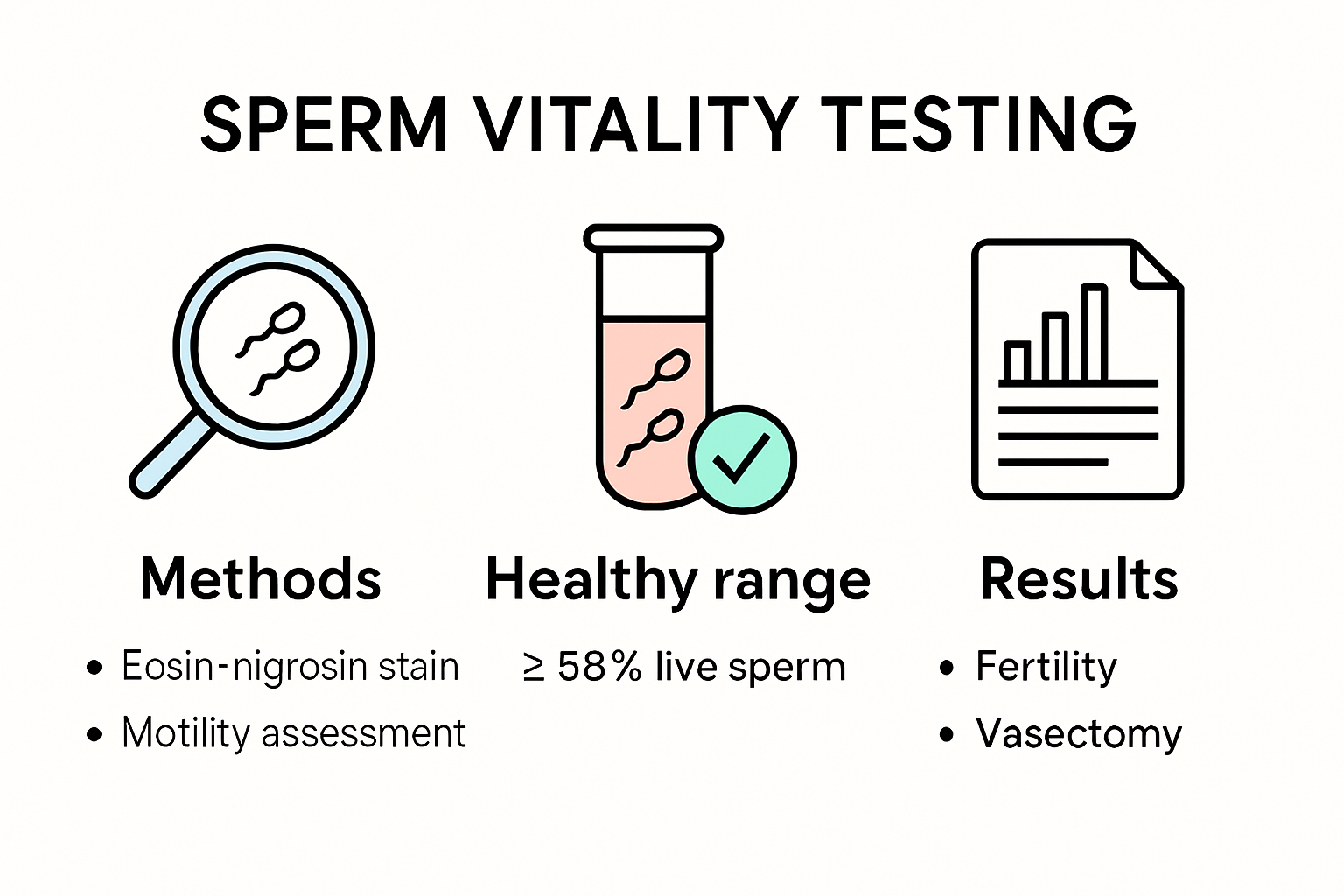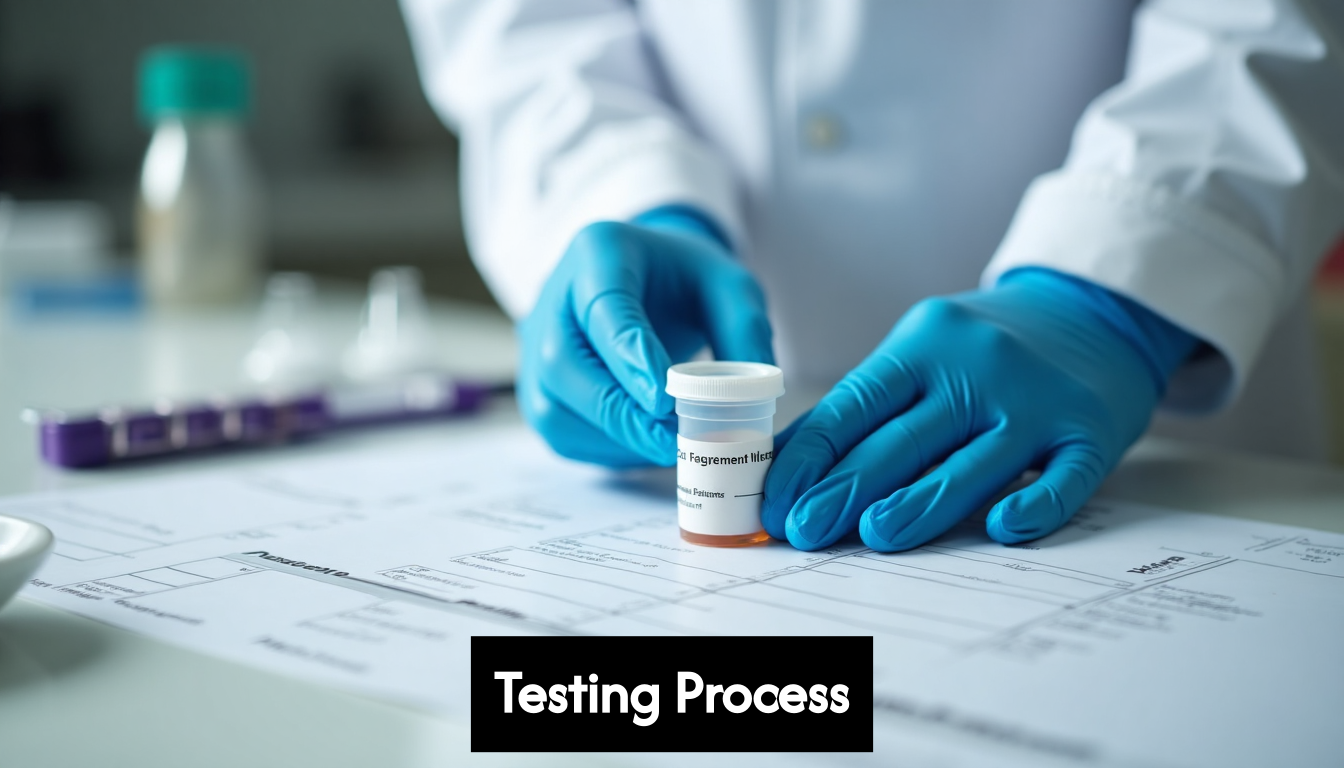Sperm vitality testing is rapidly becoming a must-have tool for reproductive health decisions in 2025. Here’s the shocker. A standard semen analysis does not always tell you if sperm are alive or just present in the sample. The real revelation is that sperm vitality testing measures the percentage of live sperm, with a healthy range set between 54 percent and 97 percent. This single number can tip the balance in fertility planning or offer absolute clarity after a vasectomy. The real story hides in these numbers, and what they reveal could change your next steps in family planning.
Table of Contents
- What Sperm Vitality Testing Reveals And Why It Matters
- How Sperm Vitality Testing Works After A Vasectomy
- Sperm Vitality Testing For Couples Facing Fertility Challenges
- Understanding Your Results And Next Steps
Quick Summary
| Takeaway | Explanation |
|---|---|
| Sperm vitality testing is crucial for assessing reproductive health. | It measures the percentage of live sperm in a sample, providing deeper insights into male fertility beyond basic sperm counts. |
| Optimal sperm vitality range is 54% to 97%. | Results falling outside this range may indicate underlying fertility issues or health conditions that need further evaluation. |
| Post-vasectomy testing confirms surgical success. | A semen analysis is recommended 8-12 weeks after the procedure to ensure zero sperm or minimal non-motile sperm are present, indicating effective contraception. |
| Abnormal results could signal health concerns. | Low sperm vitality may be linked to genetic factors, environmental influences, medical conditions, or lifestyle choices, necessitating further investigation. |
| Strategic follow-up is essential after testing. | Consultation with a reproductive health specialist and possible repeat testing or interventions can help address identified issues and guide reproductive planning. |

What Sperm Vitality Testing Reveals and Why It Matters
Sperm vitality testing provides critical insights into male reproductive health by examining the percentage of live sperm within a semen sample. Unlike basic sperm count assessments, this sophisticated diagnostic tool delves deeper into the functional capacity of sperm, revealing potential fertility challenges or post-vasectomy success indicators.
Understanding Sperm Vitality Mechanics
Sperm vitality testing specifically measures the proportion of live versus dead sperm in an ejaculate. According to the World Health Organization, a healthy sperm vitality range falls between 54% and 97%. This test becomes particularly crucial when total sperm motility is less than 40%, offering clinicians a more nuanced understanding of reproductive potential.
The test distinguishes between live non-motile and dead sperm, which is essential for accurate fertility assessment. When sperm fail to demonstrate movement, this specialized testing can determine whether they are simply dormant or permanently non-functional. This differentiation is critical because not all non-moving sperm are dead, and not all dead sperm are immediately identifiable through traditional microscopic examination.
Clinical Significance of Vitality Assessment
Beyond basic fertility analysis, sperm vitality testing can reveal complex conditions like necrozoospermia - a state characterized by a high percentage of dead sperm. Recent medical research indicates that this condition might signal underlying health issues requiring targeted medical intervention.
Moreover, comprehensive semen analysis, including vitality testing, is increasingly recognized as a broader health screening tool. Emerging studies suggest that infertile men may have elevated risks of developing chronic conditions such as diabetes, heart disease, and depression. By providing a window into reproductive health, sperm vitality testing offers more than just fertility insights.
Implications for Vasectomy Confirmation
For men who have undergone vasectomy, sperm vitality testing becomes a critical post-procedure verification method. Our comprehensive guide on sperm function tests can help patients understand the nuanced process of confirming surgical sterility. The test ensures that not only are sperm count levels zero, but the remaining cellular material is non-viable, providing peace of mind and medical confirmation of successful contraception.
By offering a detailed snapshot of sperm health, vitality testing empowers individuals to make informed decisions about their reproductive future. Whether planning a family, confirming a vasectomy, or monitoring overall reproductive wellness, this advanced diagnostic tool delivers precise, actionable insights into male reproductive potential.
How Sperm Vitality Testing Works After a Vasectomy

Sperm vitality testing after a vasectomy is a precision diagnostic process designed to confirm the complete success of the surgical procedure. This critical assessment goes beyond simple sperm counting, providing men with definitive evidence of their contraceptive status and reproductive changes.
Timing and Initial Assessment
Cleveland Clinic recommends conducting post-vasectomy semen analysis between 8 to 12 weeks after the procedure. This waiting period allows sufficient time for the reproductive system to clear remaining sperm and stabilize. The primary objective is detecting azoospermia (complete absence of sperm) or identifying extremely low numbers of nonmoving sperm that indicate surgical success.
The testing protocol involves collecting a comprehensive semen sample under specific clinical guidelines. Addenbrooke’s Hospital emphasizes the importance of a large volume assessment to ensure accurate results. Patients typically provide a sample through specialized collection methods that maintain specimen integrity and allow for precise laboratory analysis.
Analyzing Sperm Vitality Indicators
Post-vasectomy sperm vitality testing examines multiple critical parameters. Labcorp defines reliable vasectomy success as either complete azoospermia or fewer than 0.1 million nonmotile sperm per milliliter. These strict criteria help differentiate between successful procedures and potential surgical complications.
The analysis involves advanced microscopic techniques that evaluate not just sperm quantity, but also cellular viability. Technicians assess membrane integrity, cellular response, and metabolic activity to determine whether remaining sperm cells are functional or merely remnant tissue. This sophisticated approach provides a comprehensive understanding of the vasectomy’s effectiveness beyond simple sperm count.
Post-Testing Considerations
Men considering a comprehensive approach to semen testing should understand that a single test might not always provide conclusive results. Some healthcare providers recommend multiple analyses to confirm sustained sterility. Persistent sperm presence beyond six months could indicate potential vasectomy failure, necessitating further medical evaluation.
The testing process empowers men with precise, actionable information about their reproductive status. By providing clear, scientific evidence of contraceptive effectiveness, sperm vitality testing offers peace of mind and helps individuals make informed decisions about future family planning. Understanding the nuanced details of post-vasectomy testing allows men to approach their reproductive health with confidence and clarity.
Sperm Vitality Testing for Couples Facing Fertility Challenges
Couples navigating fertility challenges often find themselves at a critical juncture where precise diagnostic tools become essential. Sperm vitality testing emerges as a crucial component in understanding and addressing male reproductive health, offering nuanced insights beyond traditional fertility assessments.
Understanding Male Fertility Factors
Resolve: The National Infertility Association reveals that approximately 30% of infertility cases are directly attributed to male factors. This statistic underscores the importance of comprehensive male reproductive health evaluations. Sperm vitality testing provides a detailed examination of sperm cellular health, going far beyond simple sperm count measurements.
According to National Institutes of Health research, normal sperm vitality is defined as at least 58% live sperm, with a typical range of 55%–63%. When samples fall below this threshold, it signals potential underlying reproductive challenges that require further investigation and potential intervention.
Comprehensive Fertility Diagnostics
Sperm vitality testing offers a multi-dimensional view of male reproductive potential. The analysis examines critical factors including membrane integrity, cellular metabolism, and overall sperm functionality. Unlike basic semen analyses, this advanced diagnostic approach provides couples with a more comprehensive understanding of potential fertility barriers.
A groundbreaking European study of nearly 80,000 men discovered an unexpected correlation between semen quality and overall male longevity. This research suggests that sperm vitality is not just a fertility indicator but potentially a broader health assessment tool, emphasizing the importance of thorough reproductive health evaluations.
Navigating Fertility Challenges
For couples exploring comprehensive fertility planning, sperm vitality testing represents a critical diagnostic step. The test provides actionable insights that can guide medical interventions, treatment strategies, and reproductive decision-making. Whether considering natural conception, assisted reproductive technologies, or exploring alternative family-building options, understanding sperm vitality offers couples a clearer path forward.
The emotional and medical complexities of fertility challenges demand precise, compassionate diagnostic approaches. Sperm vitality testing bridges the gap between uncertainty and understanding, empowering couples with scientific insights and potential pathways to parenthood. By offering a detailed snapshot of male reproductive health, this advanced diagnostic tool transforms fertility exploration from a journey of guesswork to a process of informed, strategic planning.
Understanding Your Results and Next Steps
Sperm vitality testing results can be complex and nuanced, requiring careful interpretation and strategic follow-up. Understanding the detailed insights provided by these advanced diagnostic tools empowers individuals to make informed decisions about their reproductive health.
Decoding Sperm Vitality Test Results
World Health Organization guidelines define a healthy sperm vitality range between 54% and 97% live sperm. When results fall outside this range, medical professionals employ specialized assessment techniques to provide comprehensive insights. IVF Minnesota highlights two primary methods for evaluating sperm viability: membrane-exclusion dyes and the hypoosmotic solution assay (HOS), which assess plasma membrane integrity and cellular functionality.
For individuals who have undergone a vasectomy, results indicating zero or minimal nonmotile sperm represent successful surgical outcomes. Conversely, couples exploring fertility may need more detailed interpretations of their test results to understand potential reproductive challenges.
Interpreting Abnormal Results
Research from the National Institutes of Health emphasizes that abnormal semen analysis findings can signal various underlying conditions. Low sperm vitality might indicate potential issues such as:
- Genetic Factors: Chromosomal abnormalities affecting sperm production
- Environmental Influences: Exposure to toxins or radiation
- Medical Conditions: Infections or hormonal imbalances
- Lifestyle Factors: Stress, diet, and smoking
Each abnormal result requires a tailored approach, potentially involving additional diagnostic tests, lifestyle modifications, or targeted medical interventions.
Navigating Your Next Steps
After receiving sperm vitality test results, our comprehensive guide to interpreting vasectomy test outcomes can help you understand the most appropriate path forward. Recommendations may include:
- Consultation with a reproductive health specialist
- Repeat testing to confirm initial findings
- Comprehensive fertility screening
- Lifestyle and nutritional interventions
- Potential medical treatments
The journey following sperm vitality testing is deeply personal and varies for each individual. While test results provide valuable insights, they represent a starting point for understanding reproductive health, not a definitive endpoint. Professional medical guidance, combined with a proactive and holistic approach, can help individuals and couples navigate potential challenges and make informed decisions about their reproductive future.
Remember that sperm vitality is just one aspect of reproductive health. Comprehensive care involves considering multiple factors, maintaining open communication with healthcare providers, and approaching reproductive wellness with patience and understanding.
Frequently Asked Questions
What is sperm vitality testing?
Sperm vitality testing measures the percentage of live sperm in a semen sample, offering deeper insights into male fertility and reproductive health beyond standard sperm count assessments.
Why is sperm vitality testing important after a vasectomy?
Sperm vitality testing after a vasectomy confirms surgical success by ensuring no viable sperm are present or that any remaining sperm are non-functional, providing peace of mind for effective contraception.
What is the healthy range for sperm vitality?
The healthy range for sperm vitality is between 54% and 97% live sperm. Results falling outside this range may indicate underlying fertility issues that require further evaluation.
How can sperm vitality testing help couples facing fertility challenges?
Sperm vitality testing helps couples by revealing detailed insights into male reproductive health, identifying potential barriers to conception, and guiding appropriate medical interventions and fertility planning.





